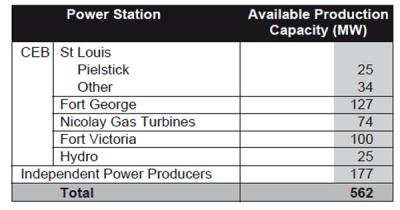Replying to a private notice question from the Leader of the Opposition on 22 November 2013, the Deputy Prime Minister (DPM) and Minister of Public Utilities has emphatically affirmed that there will be no power blackout in Mauritius in 2013 and 2014. However, an analysis of the figures given by the DPM to support his assertion reveals that there is a real possibility of a power blackout in the country in 2015.
The information given by the DPM on the power scenario in 2013 and 2014 is as follows:
(i) Latest figures show that the maximum electricity demand for 2013 and 2014 are expected to be 447 MW in 2013 and 461 MW in 2014. The figures are in accordance with those given in the CEB’s Integrated Electricity Plan which also predicts that the maximum electricity demand will be 475 MW in 2015.
(ii) The available power production capacity in Mauritius is detailed in the table below.
(iii) According to the above table, the total available capacity is 562 MW and not 565 MW as announced by the DPM. However, we shall assume that he has understated the available capacity of one of the power stations and that the total available capacity is 565 MW.
(iv) Based on the above, the DPM informed Parliament that the total available production capacity will exceed the maximum electricity demand by 118 MW (565 MW minus 447 MW) in 2013 and 104 MW (565 MW minus 461 MW) in 2014. These margins outstrip the total expected reduction in production capacity of 97 MW because of the unavailability of machines on maintenance (capacity 60 MW) and the possible failure of the biggest machine with a capacity of 37 MW. Therefore, the DPM confidently stated that there will be no power blackout in 2013 and 2014.
However, we find a bleak power scenario in 2015 when we analyse the following additional information:
(i) There will be no increase in firm available production capacity until the end of 2015 when new machines at St Louis with a total capacity of 60 MW are due for commissioning. Bidding for the procurement of the new machines has not yet started.
(ii) The Pielstick engines at St Louis with a capacity of 25 MW will be decommissioned in two years’ time i.e. before the end of 2015. This means that the total available production capacity towards the end of 2015 will be 540 MW.
(iii) Towards the end of 2015, the total available production capacity will exceed the maximum expected electricity demand of 475 MW by only 65 MW (540 MW minus 475 MW). This margin is less than the total expected reduction in capacity of 97 MW because of the unavailability of machines due to maintenance (capacity 60 MW) and the possible failure of the biggest machine with a capacity of 37 MW. Therefore, there is a real likelihood of a power blackout towards the end of 2015.
(iv) Very little rainfall in 2015 will further increase the risk of a power blackout towards the end of the same year. A rainfall deficit can reduce the available hydro capacity from 25 MW to 0 MW and, consequently, the excess of total available production capacity over maximum expected electricity demand from 65 MW to 40 MW. The margin is much less than the total expected reduction in capacity of 97 MW due to maintenance and failure of machines.
To avert a power blackout, the CEB will have to procure a gas turbine in early 2015 through emergency procedures if the evolution of power demand and rainfall at that time indicate that there will be a deficit in the availability of power production capacity in the country at the end of the same year. A gas turbine can be imported, installed, and made ready for power production within six months of ordering. However, one unit of electricity from a gas turbine costs about five times more than one unit of electricity from other CEB power stations and independent power producers. CEB’s overdependence on gas turbines (the new one and those existing at Nicolay) for power production will therefore drive up the cost of electricity. Ultimately, it is us, consumers, who will have to dig into our pockets to pay for more expensive power.
Power Blackout in 2015
- Publicité -
EN CONTINU ↻
- Publicité -

